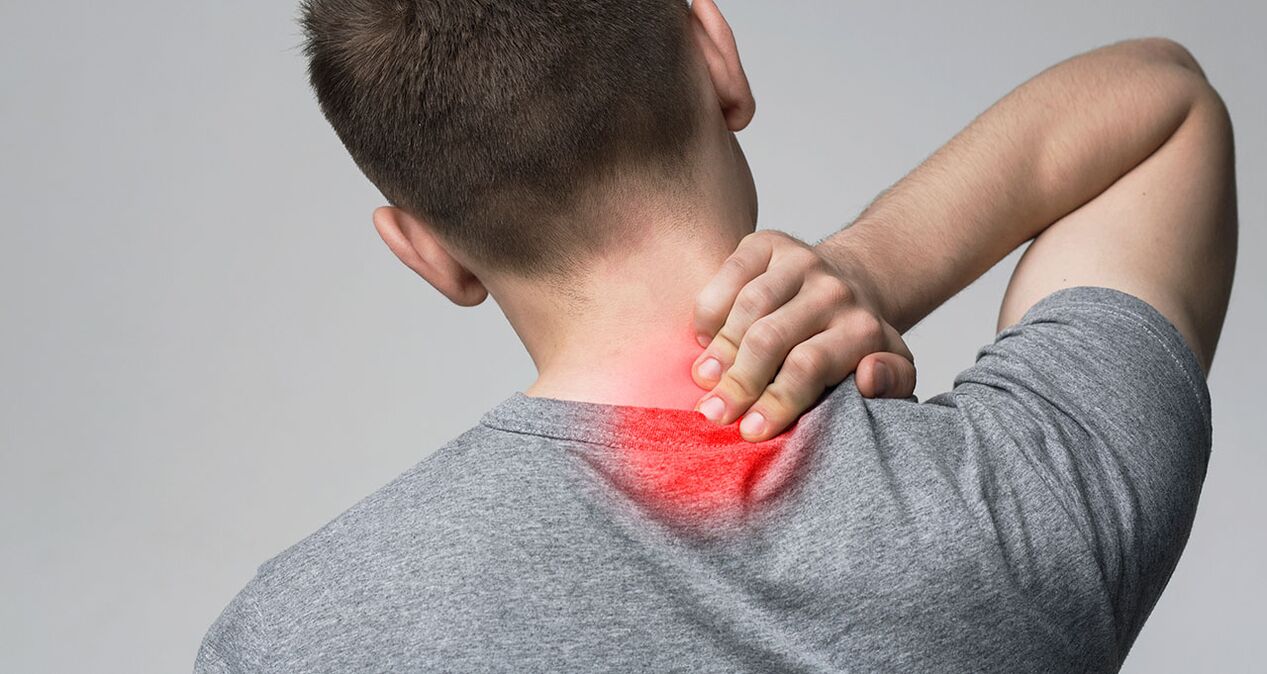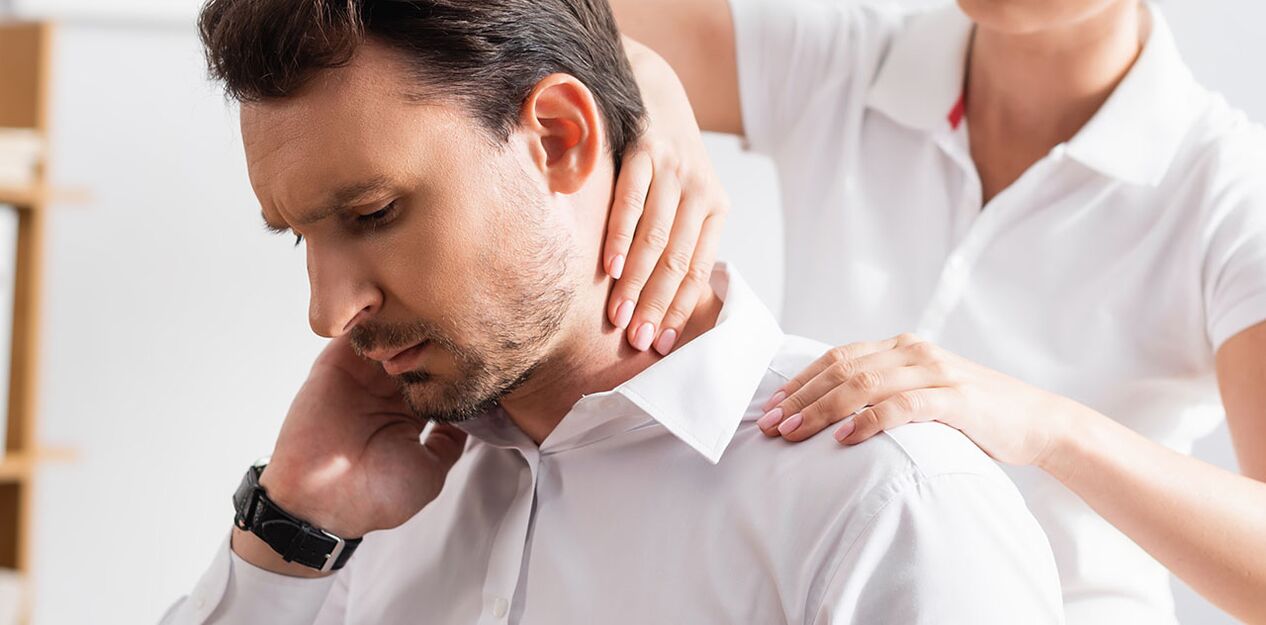
Almost two-thirds of people experience neck pain (cervicalgia). Causes include acute conditions, such as muscle strains and whiplash, and chronic conditions, such as cervical spondylosis and myofascial pain syndrome. Pinched nerves, infections, fractures, and spinal cord problems can also cause neck pain.
For effective treatment, it is necessary to understand the causes of neck pain. For this, a comprehensive examination is carried out. Based on the diagnostic results obtained, the doctor prescribes therapy. You should not self-medicate, as many cases cannot be postponed. Pain that seems harmless at first glance can cause serious complications.

general features
The neck is a sensitive area of the body - the cervical spine consists of seven vertebrae. Muscles, ligaments and nerves provide stability – the muscular structure. Poor posture or excessive tension generates overload, which reduces blood flow, causing muscle pain and myositis (inflammation).
Rarely, neck pain is felt locally. Most often it spreads to the shoulders, sometimes to the arms, to the fingers. It can be felt in the back of the head, causing headaches, dizziness and vision problems. When the neck is stiff, turning and tilting the head becomes difficult and is accompanied by severe discomfort.
Pain in the neck region varies in nature and severity. Numbness in the hands or back of the neck, hyperemia and swelling of the skin may occur. The discomfort can be short or long lasting, making everyday activities difficult.
Acute neck pain usually goes away within a few days to 2 weeks and is not a cause for concern. Neck pain is considered chronic if it lasts more than three months. If, along with neck pain, symptoms other than those mentioned appear, for example, nausea, vomiting, sensitivity to light, fever, chills, nervous disorders, symptoms of paralysis, etc. , you should consult a doctor.
Types of neck pain
Depending on the nature, neck pain can be nonspecific and specific. In the first case, we are talking about discomfort, the clear cause of which is absent. Most often it occurs due to excessive tension of the trapezius muscle. Specific pain has a specific cause associated with a specific disease.
Depending on the duration, there are:
- Acute neck pain - lasts no more than 10 days, disappears after eliminating the provoking factor.
- Chronic neck pain – persists for more than three weeks, is recurrent or constant.
According to the etiopathogenetic classification, vertebrogenic and non-vertebrogenic pain in the neck region are distinguished. In the first case, we are talking about a primary lesion of the osteochondral structures of the cervical vertebral region. It develops against the background of spondylogenic and discogenic neck pain due to compression of the spinal cord, damage to bone structures and deformation of intervertebral discs.
According to the area of localization, the pain syndrome is differentiated in the anterior, posterior and lateral regions of the neck. Each of them has specific causes. Therefore, each case requires the indication of an individual treatment plan.

Causes of neck pain
Most neck pain is nonspecific. This means that doctors cannot determine a specific medical cause for the complaints, such as injuries to the intervertebral discs or vertebrae. Often, discomfort occurs as a result of incorrect posture, which leads to muscle-fascial tension.
Neck pain occurs for the following reasons:
- sitting at the computer for a long time;
- overwork, for example, during sports or physical work;
- underdeveloped muscles;
- increased muscle tone;
- hypothermia, exposure to drafts;
- incorrect position during sleep;
- accident (whiplash, cervical spine injury);
- degenerative dystrophic changes in the spine;
- colds and viral infections;
- changes in hormones during menopause;
- stress, depression and anxiety;
- mineral deficiency.
Very rarely, neck pain is a symptom of inflammation or injury to the cervical spine. The most common cause is excessive musculofascial tension in the shoulder region. After a few days, the complaints usually disappear on their own. If the discomfort persists longer, becomes chronic or additional symptoms appear, a consultation with a specialist is necessary.
Pain in the front of the neck: causes
Discomfort of varying severity is felt on the front surface of the neck. There are many structures here, each of which can cause pain. It is not easy to determine the true cause without a comprehensive diagnosis.
The causes of front neck pain are:
- Diseases of the thyroid gland (toxic goiter, Hashimoto's thyroiditis) - discomfort occurs due to inflammatory processes and endocrine pathologies. Increased pain is observed when bending forward and during movement. Accompanied by an increase in temperature, an increase in heart rate, a feeling of heat and increased sweating.
- Sialadenitis is a lesion in the salivary glands of the jaw. The pain progresses with swallowing, chewing movements and turning the head. Accompanied by the formation of swelling and compaction. Characterized by dry mouth and difficulty eating. It occurs with weakness, chills and fever.
- Purulent inflammation in the pharynx - the inflammatory process spreads to adjacent tissue, which leads to the formation of a retropharyngeal abscess. The discomfort is accompanied by redness of the skin on the front of the neck, which becomes bright pink and hot to the touch. The pain is throbbing and intense, which is why the patient may refuse to eat. Associated with febrile fever. It is a consequence of an extensive paratonsillar abscess.
- Cervical plexitis - the intensity of clinical manifestations depends on the number of damaged nerve structures. Most often, acute pain occurs in the anterolateral part of the neck. There is difficulty coughing and speaking. The discomfort radiates to the ear, chest and back of the neck. There is a "crawling" sensation and paresthesia. It occurs due to injury, hypothermia or after vaccination.
- Rheumatic diseases are systemic connective tissue disorders (collagenosis) with damage to the skin and muscles. Dermatomyositis and scleroderma are characterized by constant, dull pain. Swelling and thickening of the skin occurs. The sharp pain radiates to the front of the neck and spine.
- Lymphadenitis - discomfort is localized in the upper part of the neck. Lymphoid tissue is affected. The discomfort is localized in the submandibular region, usually on one side. Symptoms progress with head tilt and speech. The skin becomes hyperemic and swollen. Accompanied by inflammation of the lymph nodes, general weakness and fever.
Pain in the front of the neck can also occur with atypical angina attacks. The pain is more pronounced and accompanied by shortness of breath. It becomes difficult to speak and there is difficulty swallowing.
The pain is localized in front also with inflammation of the mucous membrane of the trachea and esophagus. Discomfort is a consequence of painful coughing and tracheitis. Rare causes include cervical compression syndrome and spinal injuries.
Neck pain: causes
Discomfort in the back of the neck is a consequence of prolonged work at the computer and a low level of physical activity. Pain occurs due to pathological changes in the spine.
Neck pain has the following causes:
- Osteochondrosis is accompanied by degenerative-dystrophic disorders of the intervertebral discs, a decrease in their strength and a decrease in height.
- Protrusions are a complication of osteochondrosis, accompanied by protrusion of the intervertebral disc. The bumps are caused by infringement of the vertebral artery and nerve structures.
- Intervertebral hernias occur when the protrusions are advanced. The internal contents of the intervertebral disc exit into the spinal canal, compressing the nerve endings.
- Spondylosis – bony protrusions (osteophytes) appear at the edges of the vertebral bodies, while the intervertebral discs decrease in size, adjacent vertebrae fuse, and neck mobility is limited.
Neck pain is characteristic of myofascial syndrome, in which individual muscles spasm. Accompanied by sharp pain when pressing on the back of the head, as well as during physical activity.
Among systemic diseases, ankylosing spondylitis can be distinguished, which affects joint structures and is characterized by limited mobility. Accompanied by the formation of fixed and durable conglomerates due to the fusion of individual vertebrae with each other. Less commonly, neck pain is associated with spinal tuberculosis, Reiter's syndrome, and osteomyelitis.
A more serious cause that requires emergency medical attention is a spinal compression fracture. It occurs due to a cervical injury to the neck.
Side neck pain: causes
Pain in the side of the neck may be throbbing, tingling, or burning. It radiates to the shoulder or ear. Accompanied by the formation of secondary torticollis. This causes the head to tilt towards the affected side. Typical of atherosclerosis and other blood vessel diseases.
The cause is also muscle spasm that occurs during sudden movements, excessive stress and hypothermia. Pain on the side of the neck is observed with malignant processes in the larynx, pharynx and thyroid gland. You shouldn't leave things to chance. If primary symptoms appear, you should consult a doctor. This approach allows you to take timely treatment measures and eliminate the development of complications.
Diagnosis of the causes of neck pain
The examination includes laboratory tests and instrumental diagnostics aimed at visualizing the affected areas and identifying signs of pathology:
- Ultrasound of the submandibular salivary glands and thyroid gland - is prescribed for quick visualization of cervical structures and identification of diseases of internal organs that cause pain in the neck. Duplex scanning is performed to examine large vessels and determine the status of blood flow.
- Radiographic examination or computed tomography (computed tomography) - determines the displacement of the vertebrae and bone deformations. Allows you to determine the degree of vertebral disorders and the nature of the disorders.
- Functional diagnosis - damage to the muscular system is determined by MRI of the cervical spine.
A blood test is performed to confirm inflammatory processes. The level of thyroid hormones is also determined. If there are general infectious symptoms, a bacteriological culture or throat swab is prescribed. Serological tests (PCR, ELISA, RIF) are also necessary.

Neck pain treatment
For neck pain, conservative rather than surgical treatment methods are prescribed. Drug treatment aims to relieve pain, eliminate the cause of discomfort and restore the body. Therapy is prescribed depending on the stage of the pathology, the cause of the disorders that have occurred, the age and characteristics of the patient's body.
To increase the effectiveness of the medications used, physiotherapy and physiotherapy are prescribed. Manual techniques are effective. In some cases, if the expected result is not achieved, surgery is performed.
Help before diagnosis
Tilts and rotations of the head, as well as light massage, help relieve sharp neck pain. The tension gradually decreases, which helps to improve the condition. There are muscle knots or trigger points in the neck muscles that cause discomfort when irritated. Gently rubbing and massaging helps relieve pain.
For the first 24 hours after discomfort, you can use cold or hot compresses. Heating the neck with a heating pad is only permitted from the side or from behind.
Pills and ointments for neck pain
It is recommended to take any analgesic that temporarily improves the condition. An NSAID is prescribed, which not only relieves pain, but also has an anti-inflammatory effect.
For local effects, you can apply a warming patch or ointment. They relieve hyperemia and swelling, which reduces pressure on nerve endings and reduces spasm.
Exercises for neck pain
For moderate pain, you can perform light gym exercises on your own. It is important to monitor your well-being so as not to cause harm.
Smooth, non-sharp movements will help reduce discomfort:
- lie on your back, press your head against a flat, but not soft pillow until you count to 5 (from 5 to 7 approaches);
- lie on your side, raise your head and hold until you count to 5 (at least 5 approaches);
- lie on your stomach, cross your arms behind your neck, lift your head, providing light resistance (4 to 6 sets).
In case of acute and intense pain, any exercise is contraindicated. You should stop exercising if you feel dizzy or weak. In this case, the Shants collar will help reduce pain. Immobilization should not be prolonged. Otherwise, the muscular corset will weaken and the situation will worsen.
What not to do if you have neck pain
If frequent discomfort in the cervical spine occurs, it is unacceptable:
- Maintain a forced position of the body for a long time, in which the neck is tense.
- Lift heavy objects and do physical work.
- Being exposed to severe stress, which causes vasospasm, which negatively affects blood circulation.
- Frequent drinking alcohol and smoking, which contribute to a persistent narrowing of vascular structures.
- Dress inappropriately for the weather, avoid drafts and do not wear a hat or scarf in the cold season.
It is unacceptable to sleep on a soft mattress and high pillow. It is necessary to avoid sudden turns of the head, which can lead to sudden compression of the nerve.
When you need to see a doctor urgently
Specialist help is necessary if the pain does not subside after 5-7 days or intensifies. You should see a doctor if you experience severe pain that prevents you from falling asleep and does not ease when you change body position.
The absolute indication for a visit to the clinic is a deterioration in general health - the appearance of nausea, dizziness and weakness. Hand numbness also requires professional help.

Drug treatment
Combination therapy is usually prescribed, which includes:
- non-steroidal anti-inflammatory drugs – relieve discomfort and swelling, eliminate residual inflammation;
- analgesics – relieve pain and improve general condition, but do not eliminate the cause;
- corticosteroids - reduce inflammation, affect muscle excitability;
- muscle relaxants – relieve painful muscle tension, improve motor activity.
In case of severe pain, injections into trigger points are indicated. Antioxidants, anticonvulsants and antidepressants are also prescribed.
Chondroprotectors stop inflammation and degenerative processes in the spine. Vitamins improve blood circulation and have a healing effect.
Surgery
The operation is performed to restore the functionality of the cervical spine. The most commonly used decompression tactics are indicated for compression syndrome, when nerve roots are compressed by a pathological defect. Microsurgical discectomy, laminectomy and nucleoplasty are used. Also, for pain in the cervical spine, stabilization techniques are popular - arthrodesis, vertebroplasty, implantation of a bone tissue fragment and installation of fixed metal structures.
Surgical intervention aims to eliminate the cause (hernia, tumor, osteophytes, etc. ). The purpose of the operation is to restore the motor support functions of the spine. After surgical treatment, long-term rehabilitation is required, which is necessary to prevent various complications, which are not uncommon. The results of the operation depend on the timeliness of the procedure and compliance with medical recommendations for recovery.
Manual therapy
The minimally invasive technique involves the use of manual techniques. Efficacy targets joints, muscles, ligamentous-articular and bone structures. Manual therapy improves the condition of spinal hernias, poor posture, protrusion and osteochondrosis. Improves the condition of neck pain.
A course of manual therapy restores mobility, restores damaged tissues and eliminates dizziness. The pain gradually subsides, the back and neck muscles relax. The patient's well-being improves.
Physiotherapy
Physiotherapy treatment is aimed at the influence of magnetic field, electric current, temperature and mechanical effects on the body. The procedures are painless and do not cause adverse reactions or complications if you follow the doctor's recommendations. Physiotherapy is indicated for the treatment of chronic diseases and is prescribed for preventive purposes. Used to strengthen the immune system, treat chronic inflammation and improve posture. The procedures increase the effectiveness of medications.
Physiotherapy treatment for neck pain includes:
- SMT (sinusoidal modulated currents) - stimulate the production of biologically active substances in the body. Electrophoresis relieves pain and restores mobility by activating one's own defenses. The complex of procedures allows you to obtain a pronounced and long-lasting analgesic effect, complemented by anti-inflammatory and anti-edematous effects.
- MLT (magnetic field and laser beams) – provides a pronounced therapeutic effect. The procedure aims to activate specific enzymes, change capillary osmotic pressure and improve blood circulation.
- UVT (shock wave therapy) - with the help of low-frequency acoustic waves, processes are launched that improve microcirculation. Inflammation is reduced, swelling is eliminated and pain is reduced.
To obtain a pronounced effect, it is recommended to carry out a series of physiotherapeutic procedures. Improvements, as a rule, are observed after the first session. Physiotherapy is contraindicated in acute inflammation. Prescribed when the process is chronic and in the recovery phase.
Exercise therapy
Therapeutic physical culture aims to create the muscular structure of the neck, eliminating tension and restoring blood circulation. An individual approach is used for each patient, taking into account their capabilities and needs.
The physiotherapy program is drawn up by a doctor, taking into account the medical history and contraindications. If necessary, adjustments are made taking into account the dynamics of the patient's condition, which eliminates the development of complications and allows you to obtain the expected result.
When starting a series of exercises, it is important to consider:
- the main task is to tone the muscles, they need to become elastic;
- it is important to carry out the movements smoothly, as sudden and quick movements will only aggravate the condition;
- Exercises must be performed on a flat surface, using a mat and special rollers.
It is important to observe regularity and frequency. If discomfort occurs, it is necessary to reduce the load.
Exercises to restore the plasticity of muscular structures and improve the mobility of the vertebrae:
- Exercise #1 – Turn your head to the far right and then to the left. Provides mobility of the cervical vertebrae.
- Exercise #2 – Lower your head, pressing your chin against your chest to feel your chest cavity. This exercise improves neck mobility and relieves muscle stiffness.
- Exercise #3 – Move your head back, retracting your chin. Exercise improves cervical spine posture.
A set of exercises has also been developed to strengthen weak muscles in order to create a muscular corset and reduce pain. While sitting, place your hand on your forehead and tilt your head forward to create resistance. You can also perform similar tilts to the right and left.
Which doctors should I contact for neck pain?
If discomfort occurs, you should visit a therapist. Based on complaints, a general practitioner will prescribe an examination and, if necessary, refer you to a specialist - a neurologist, endocrinologist or oncologist.

conclusions
Between 30 and 70% of the population experience neck pain. This problem reduces quality of life and often leads to disability. With timely consultation with a doctor and treatment, the prognosis is usually favorable.
Therapy for neck pain includes physical, behavioral and pharmacological methods. The most effective are therapeutic exercises, manual therapy, proper organization of the workspace and compliance with ergonomic rules. NSAIDs, injections and antidepressants are prescribed. In advanced cases and when conservative treatment is ineffective, surgery is performed.


















